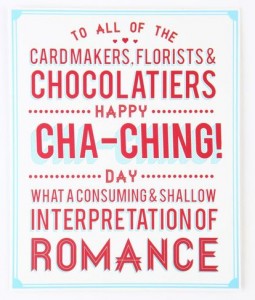Authentic Love: Producing and Consuming Valentines Day
Happy Valentines Day! Or as one friend on my Facebook likes to call it, “Happy season of heteronormative displays of materialist consumption”. Ouch.
Valentines Day is often criticized in the popular media for being a ‘commercialized’ or ‘overly-commercialized’ “Hallmark Holiday”, engineered by chocolate and card companies to drive up profits (See: http://www.huffingtonpost.com/kira-sabin/why-i-hate-valentines-day_1_b_4763153.html). Valentines Day celebrations are thus obligatory, inauthentic expressions of love, which apparently should be spontaneous, if not constant, and transcend materiality.
For a nuanced argument about the ‘dark side’ of Valentines Day commodities, see Martin Donohoe’s (2008) Flowers, Diamonds, and Gold: The Destructive Public Health, Human Rights, and Environmental Consequences of Symbols of Love (http://www.jstor.org/stable/20486701). For a far less nuanced view: a group of mens’ rights activists have in fact planned a “Smash Valentines Day” protest against the “oppressive chocolate capitalists”: http://time.com/money/3707784/valentines-day-protest-haters/
The history of Valentines Day, and its modern commercialization, is of course far more nuanced, and I encourage you to have a quick look at its origins, from the martyr of St Valentine in the 3rd century by the oppressive Roman Emperor, to the writing of love sonnets in the 18th century by Geoffry Chaucer and friends (the origins of the ubiquitous “roses are red…”) and the first mass-produced valentines of embossed paper and lace, produced and sold in 1847 by Esther Howland of Worcester, Massachusetts (https://www.the-newshub.com/relationships/valentines-day-a-brief-history-of-commercial-cringe).
In this week’s readings, Cavanaugh and Shankar (2014) demonstrate how ideas of authenticity, rather than acting as the antithesis of commercialization, is actively created and used by companies to market their products. Authentication as a delicate and “inherently iterative” process through which cultural attributes are given material form (2014:61). The Guardian gives a round-up of recent attempts at “authentic ads” produced for the Valentines Day market (http://www.theguardian.com/media-network/2015/feb/13/authentic-ads-win-valentines-day). These new advertisements attempt to break away from cliched ideas of roses and fairytales, to embrace ‘real-life’ and diverse stories of love (for example, Tiffany & Co use a gay male couple in their latest ad). One interesting example is McDonald’s “Pay with Lovin'” campaign ad that ran during the Superbowl, which lets people pay for their food ‘with love’, for example by ringing their mother/child/friend and declaring that they love them. (
). It might be interesting to discuss the tensions between authenticity as it is produced by companies, and authenticity as it is received by consumers – I find these marketing campaigns more insidious than ‘genuine’, but then again, perhaps there is no such thing as an ‘authentic’ Valentine?
And a final Valentines day gift from me to you all: #anthrovalentines (https://storify.com/DonnaLanclos/anthrovalentines)
Contributed by HannahHarewood Gould on 15/02/2015







